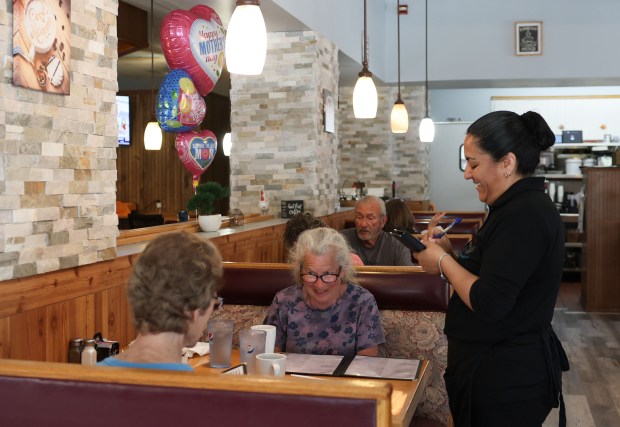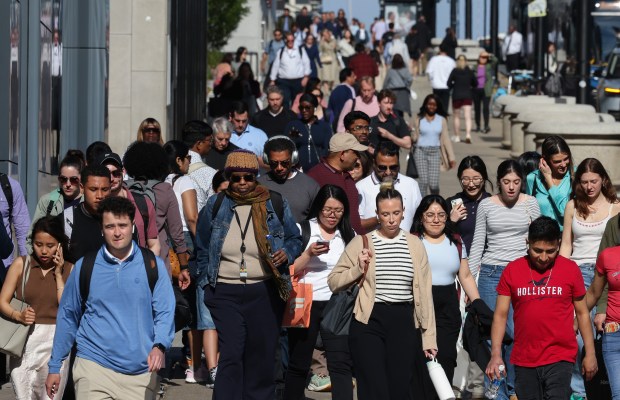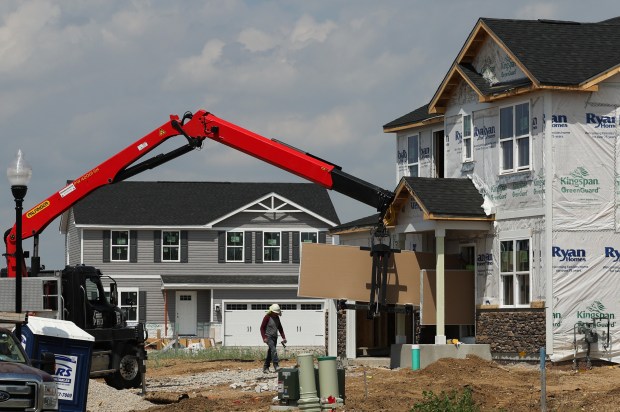Chicago posted the seventh biggest population gain of any city in the country last year, leading a wave of growth that also lifted many suburbs, particularly those on the fringes of the metro area.
The city of Chicago added 22,164 residents between mid-2023 and mid-2024, according to new estimates from the U.S. census. That population growth works out to a percentage gain of only 0.8%, but it marks the second year in a row that Chicago’s population grew, reversing a downward trend in previous years. Demographers say the uptick was probably due to the arrival of migrants, many of them on buses sent from Texas, as well as people coming on their own.
Growth also expanded Chicago’s far outlying suburbs, such as Plainfield, which led the region with nearly 4,000 arrivals since 2020, followed by Naperville, Warrenville, Montgomery, McHenry and Joliet. Meanwhile, inner suburbs such as Cicero, Berwyn, Evanston and Oak Park, along with middle suburbs such as Schaumburg and Oak Lawn, have seen their populations decline since 2020.
In Chicago, the growth is a sign the city shows “remarkable resilience” and is a “world-class destination,” Mayor Brandon Johnson said in a statement. He touted several recent formal challenges to census data made by his administration that corrected previous undercounts.
The growth shows “Chicago is leading Illinois in the right direction,” Johnson said.
But Chicago’s population peaked in 1950, and the increase is likely to be temporary, if the Trump administration continues to severely limit immigration, according to Rob Paral, senior researcher at the Great Cities Institute of the University of Illinois Chicago.
“Most large American cities depend on immigration to renew their population,” Paral said. “So when you cut immigration, it’s almost deadly for cities. We’d expect almost every large American city to suffer in terms of workforce, and the number of consumers and taxpayers.”
The pattern in the suburbs, though, is likely to keep going.
“This looks like a continuation of a pattern we’ve had for quite some time,” Paral said. “The decline in the inner suburbs, the mild decline in the next outer ring of suburbs, and extreme growth on the fringes of the region.”
The outlying areas are thriving because of new, relatively affordable housing construction, good schools, and lower crime and taxes, residents say.
In Hampshire, on the farmland edge of Chicago’s northwest suburbs, business has been growing at the new Angel’s Pancake Cafe opened last year by Angel Garcia and his father. They’re expanding outward from restaurants they operate in Hinsdale and Morton Grove.
“Business has been picking up ever since we took over,” Garcia said. “We’ve had a good amount of customers who started to move more toward Hampshire. It’s a nice, friendly, peaceful environment.”

Some projects that fell through because of the recession in the early 2000s are set to pick back up, as the village approved around 500 new residential units in the past four years, Village President Mike Reid said. Hampshire’s downtown area has also seen changes as its population grew.
“In 2017, you could’ve taken a bowling ball and roll(ed) it down State Street any day of the week and not hit a thing,” Reid said. “And now, people get frustrated because they can’t find a parking spot right in front of the business they want to go to.”
In far west suburban Elburn, a few subdivisions are under construction to accommodate recent population growth, Village President Jeffrey Walter said.
But Walter said Elburn is not necessarily aiming for constant expansion, and that village leadership has long believed in building on existing land, rather than annexing new plots and expanding their boundaries.
“We like the green space around us,” Walter said. “Elburn is not the farm town it used to be, but it’s still, we’re surrounded by farmland. … We don’t want to end up like the suburbs to the east that you don’t know what town you’re in when you’re driving down.”

That’s part of the pull for individuals moving there, he said.
“It’s funny, when you talk to people that have moved out here, they don’t want any more growth,” Walter said. “They moved out here ‘cause it’s quiet and they wanna keep it that way, and they would be happy with no more growth. But you can’t, you’re not gonna stop it.”
Plainfield, Chicagoland’s top population riser outside the city since 2020, can credit its growth to a holistic approach, Village President John Argoudelis said.
The southwest suburban village that added 3,980 people since April 2020 — including another 1,274 in the most recent measured year — is no longer a “small farm town.” Now, newcomers view it as a “more quaint version of Naperville,” he said.
“It’s not just things like economics, traffic and taxes. It’s about inclusion, arts and culture,” he said. “We’re really pushing hard on our green spaces, our trails. We’re really looking at the whole big picture.”
Argoudelis touted a 10-year plan to spend $160 million on infrastructure. The city has a water system, sewage plant, schools and open land to welcome more people, he said. But his focus is on spurring more business development to shift the tax burden off homeowners, he added.
“We’re not anti-growth, but we’re not necessarily saying we need to build thousands of houses either,” Argoudelis said. “We’re taking it as it comes.”

Nationally, cities of all sizes grew on average from 2023 to 2024, with Southern and Western cities experiencing accelerated growth, the census reported. Topping the list of fastest-growing cities was Princeton, Texas, with a remarkable 30.6% growth rate. New York City, Houston and Los Angeles saw the greatest numeric gains during this time and some cities in the Northeast and Midwest marked their first population increase in recent years.
Chicago remained the third-largest city in the nation, with 2,721,308 residents. New York was the nation’s largest city, with a population of 8,478,072. Los Angeles was the second largest, with a population of 3,878,704, according to the census estimates.
Chicago Tribune’s Stacey Wescott contributed.




